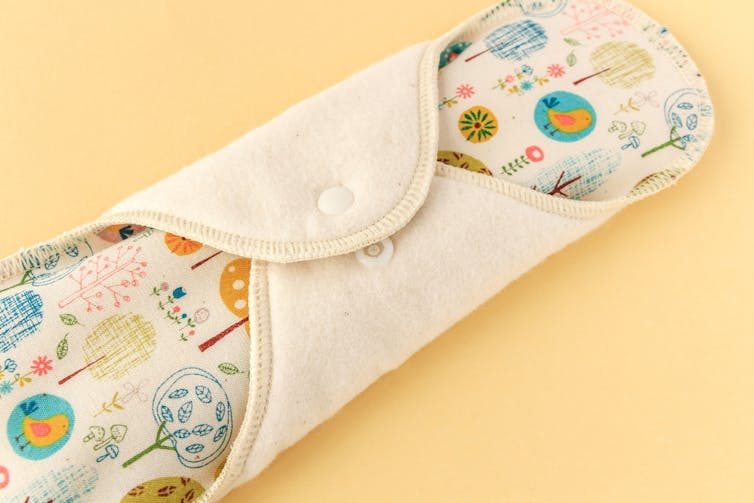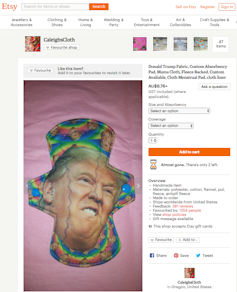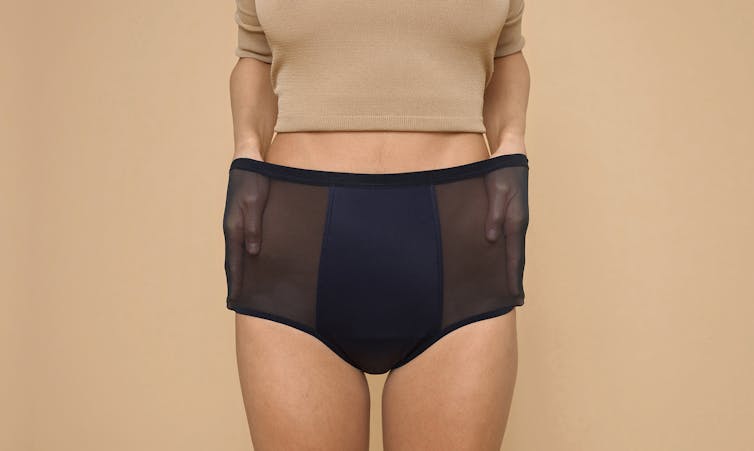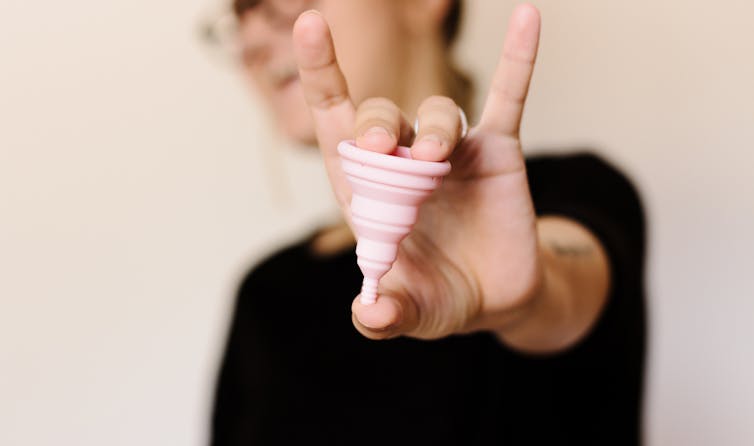Cups, lingerie and home-made pads: what are the reusable options for managing your period?
- Written by Lauren Rosewarne, Senior Lecturer, University of Melbourne
The multi-million dollar feminine hygiene market is dominated by two products: pads and tampons. Most women will use one of the two – pads most commonly – for reasons including ease of purchase, convenience, comfort, discrete packaging, disposability and, of course, advertising.
Pads and tampons, however, are not the only choices.
While you can free bleed at one end of the spectrum or period suppress at the other, in this article I focus on those of us electing to manage the 40-ish millilitres of blood we lose each each month.
Be it because of concerns over big femcare, landfill, cost, toxic ingredients or toxic shock syndrome, some menstruators seek solutions outside of the Kotex box. These are those choices.
Read more: Tampon versus pad: why more women still choose the latter to manage periods
Absorption approaches
Tampons and pads work by absorbing blood. These products are generally single usage and afterwards are discarded and replaced with a new product.
“Rags” hasn’t always been a crude euphemism for menstruation; it references a time when cloth was used, bled on, and then washed and used again.

Reusable pads often have press studs to secure them to your underwear crotch. ayakaphoto/Shutterstock
Wealth in the West, and the clout of the feminine hygiene industry however, has meant that today most of us won’t consider reusable options. But such products are readily available and seek to overcome many of the problems created by disposables.
In Australia, companies such as Hannahpad, Paisley Pads and Mense Sense sell cloth pads that can be reused. Less like the rags of old, reusable pads resemble the winged and form-fitting supermarket versions – often boasting press studs to secure them to your underwear crotch – and are designed to be washed and reworn.
For those seeking non-pad absorption methods, welcome to the world of menstrual lingerie. Brands like Knixteen, Thinx and Modibodi

The fabric options for reusable pads are endless. Screenshot from Etsy
Such pads are marketed to eco-conscious consumers who like not having to buy new products every month from big companies, who prefer non-bleached materials, who appreciate the comfort of natural fabrics and who are, perhaps, drawn to the whimsy: if you’ve ever yearned to bleed on Donald Trump’s face, rest assured you now can. And Etsy will also be more than glad to offer you a range of festive designs featuring Dirty Dancing, unicorns, rapsberries and pretty much anything else you’ve ever craved to drip, clot and smear over.
Equally, if you’re keen to break out the sewing machine, you can sew your own. Ditto those who want to knit their own pads.
For those seeking non-pad absorption methods, welcome to the world of menstrual lingerie. Brands like Thinx and Modibodi sell absorbent underwear that can be worn without any additional protection: Thinx, for example, claims that some of their knickers can hold up to two tampons’ worth of blood.

Period knickers absorb blood. Thinx
Reviews caution that you don’t want to be a heavy bleeder in such garments, but then if you are, they can serve as a backup if you’re prone to bleeding through your other protection.
If internal products are your preference, perhaps resuable tampons should be on your radar. Less common than washable pads, nonetheless, flannel ones – and crocheted ones for those who don’t harbour the same internal-wool squeamishness that I do – abound on Etsy. For the crafty you too can make your own.
Sea sponges are also a product in this category. When Elaine on TV sitcom Seinfeld debated a man’s sponge-worthiness she was talking about a contraceptive sponge, but their use for blood absorption is emerging as a niche, albeit not uncontroversial method (think concerns about grit and disintegration inside the vagina).
Read more: Explainer: why do women menstruate?
While there are price and planet reasons for considering resuables, there are also some notable downsides.
To reuse any kind of feminine hygiene product you have to wash it. If you’ve ever stained your sheets, clothes, or the carpet, you’ll be well aware that the scarlet stuff is a bastard to remove. If you’re bleeding away from your laundry, you’ll also need to think about transporting your blood-soaked pads or tampons back to your bucket, before soaking, washing and drying them.
Advertising’s heavy-handed messages about hygiene and discretion help explain our disproportionate reliance on brand-name pads and tampons, but convenience is just as potent a factor.
Collection choices
Menstrual cups – an option increasingly available in bricks and mortar stores and also one carving out a market beyond earth mothers – are a menstruation management premised on the collection of blood.

Cups are inserted into the vagina and collect blood, then are washed and reinserted. Martin Grincevschi/Shutterstock
Brands like Mooncup, Juju, Lunette and DivaCup offer cups made from silicone, rubber or latex which get inserted into the vagina using fingers and your favoured folding technique. Once inside, they unfurl to collect blood and then later get removed, emptied and then washed (or, at least wiped) and reinserted.
While there’s no soaking or pegging products out on the washing line, menstrual cups have some of the same cons as tampons: some users report difficultly inserting them; others are reluctant to have so much contact with their own bleeding vaginas.
Read more: The ongoing taboo of menstruation in Australia
Equally, while you may not have to soak your cup, you’re certainly going to have to sterilise it at the end of each cycle. (For those wanting to skip this step, Softcups and Flex offer disposable versions).
And if you’re choosing cups because of the real but often exaggerated fears of toxic shock syndrome, you’ll want to make sure that your hands are pristine before fiddling about with insertion.
Some menstruators will spend 30-ish years using the same products they were introduced to at menarche; commonly whatever their mother, sister or friend handed them at that moment of crotch calamity.
We’re also, apparently, a brand loyal lot, sticking with the names we’re familiar with. The leakage and odour fears drilled into us from youth have meant that we commonly need a very good reason to deviate from the methods we’ve successfully used to stem the crimson tide.
That said, for some women, economics, the environment and the eschewing of ever-enlarging enterprises might prove such a reason.
Dolly Parton, “PMS Blues” (1994)Authors: Lauren Rosewarne, Senior Lecturer, University of Melbourne



